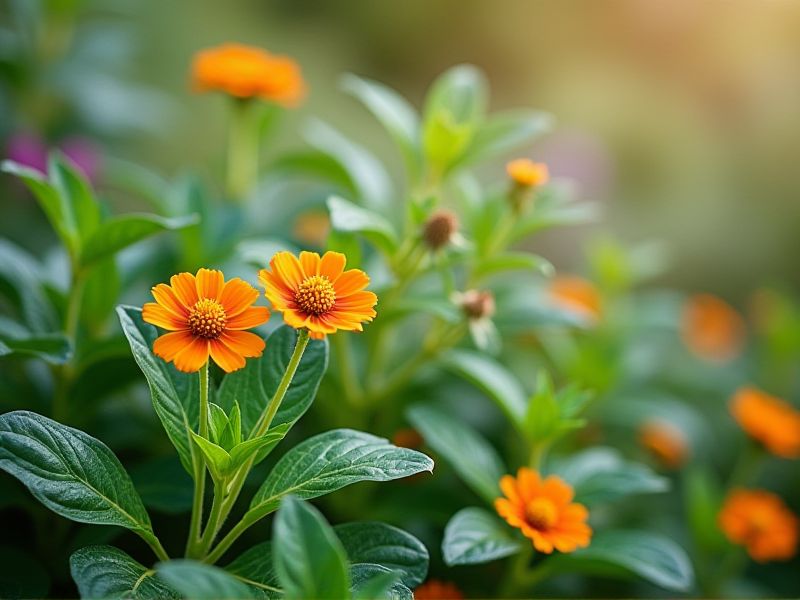
Native plants such as lavender, sage, and Arizona desert wildflower are excellent choices for conserving water in your landscape. These species have adapted to the local climate and require less irrigation compared to non-native plants, making them ideal for dry regions. Incorporating native grasses like blue grama or buffalo grass can further enhance your garden's drought resilience while providing habitat for local wildlife. Additionally, plants such as yucca and agave store water in their leaves, minimizing the need for frequent watering. By choosing these native options, you can create a sustainable garden that thrives on minimal water input.
List of some Native plants that conserve water
- Aloe Vera (Aloe barbadensis)
- Golden Barrel Cactus (Echinocactus grusonii)
- Agave (Agave americana)
- California Poppy (Eschscholzia californica)
- Red Yucca (Hesperaloe parviflora)
- Little Bluestem (Schizachyrium scoparium)
- Woolly Senecio (Senecio haworthii)
- Creosote Bush (Larrea tridentata)
- Blue Fescue (Festuca glauca)
- Purple Coneflower (Echinacea purpurea)
Important things about Native plants that conserve water
Adaptation To Arid Climates
Native plants in arid climates, such as succulents and xerophytes, have evolved specialized adaptations to efficiently conserve water. These plants possess deep root systems that tap into underground moisture, and many feature thick, fleshy leaves that store water, enabling them to survive prolonged dry periods. Examples include the saguaro cactus with its ribbed structure that minimizes surface area and the agave plant, which utilizes a unique photosynthesis process called CAM (Crassulacean Acid Metabolism) to reduce water loss during the day. Incorporating such native plants in your landscaping not only supports local biodiversity but also promotes sustainable water usage in your garden.
Deep Root Systems
Native plants with deep root systems are crucial for conserving water in arid environments. These plants, such as mesquite trees and certain wildflowers, can access moisture from deeper soil layers, making them resilient during drought conditions. By planting these species in your landscape, you promote sustainable gardening practices and reduce the need for irrigation. Furthermore, deep-rooted native plants improve soil health by preventing erosion and enhancing nutrient cycling.
Drought Tolerance
Native plants, such as lavender and sagebrush, exhibit remarkable drought tolerance, making them ideal for water-wise gardens. These species have adapted to local climates, developing deeper root systems that allow them to access moisture from the soil efficiently. By incorporating drought-resistant native plants into your landscape, you not only reduce water consumption but also support local ecosystems and wildlife. Furthermore, these plants often require minimal maintenance, making them a sustainable choice for environmentally conscious gardeners.
Lower Maintenance Requirements
Native plants are exceptionally suited for conserving water in your garden, as they are adapted to local climates and soil types. By incorporating species like the California poppy, desert sage, or purple aster, you can create a vibrant landscape that thrives with minimal irrigation. These plants typically have deep root systems that access groundwater, reducing the need for frequent watering. Utilizing native flora not only supports local wildlife but also contributes to the sustainability of your gardening practices.
Soil Health Improvement
Native plants significantly enhance soil health by improving moisture retention and reducing erosion. Their deep root systems create natural channels that allow water to penetrate the soil more effectively, promoting better water conservation in your garden or landscape. By attracting beneficial microorganisms and pollinators, these plants foster a vibrant ecosystem that contributes to nutrient cycling and soil fertility. Embracing native flora can lead to sustainable land management practices that not only support local biodiversity but also ensure long-term soil vitality.
Wildlife Habitat Support
Native plants such as California lilac and desert marigold are excellent choices for conserving water while supporting local wildlife habitats. These plants are specifically adapted to their environments, requiring less irrigation once established and providing essential food and shelter for native pollinators. Incorporating drought-resistant native species into your landscaping can enhance biodiversity, attract beneficial insects, and reduce the need for chemical fertilizers and pesticides. By selecting native flora, you create a sustainable ecosystem that supports wildlife while minimizing your water usage.
Reduced Erosion
Native plants play a crucial role in reducing erosion and conserving water within their ecosystems. Their extensive root systems stabilize soil, preventing it from washing away during heavy rainfall or storms. Furthermore, these plants are adapted to local climate conditions, requiring less water and minimizing the need for irrigation, which helps maintain groundwater levels. By incorporating native species into landscaping, you can effectively enhance soil health while promoting biodiversity and water conservation in your area.
Natural Pest Resistance
Native plants play a crucial role in enhancing natural pest resistance while conserving water resources. By adapting to local conditions, these plants promote biodiversity, attracting beneficial insects that prey on harmful pests, thereby reducing the need for chemical pesticides. Additionally, their deep-root systems improve soil health and moisture retention, which is essential in drought-prone areas. Incorporating native plants into your landscaping not only supports the local ecosystem but also requires less water, making it a sustainable choice for gardeners.
Seasonal Water Retention
Native plants such as desert marigold (Baileya multiradiata), California poppy (Eschscholzia californica), and sagebrush (Artemisia tridentata) are essential for conserving water in arid regions. These plants are naturally adapted to local climates, requiring minimal irrigation while thriving in poor soil conditions. By utilizing deep root systems, they effectively tap into underground water sources and reduce surface evaporation, making them ideal for sustainable landscaping. Incorporating these native species into your garden not only promotes biodiversity but also helps manage seasonal water retention efficiently.
Climate Resilience
Native plants play a vital role in enhancing climate resilience by conserving water in ecosystems. These plants are adapted to local climates and soils, making them more efficient at utilizing rainfall and reducing the need for supplemental irrigation. By integrating native species into landscaping, you can promote biodiversity and create habitats for local wildlife, while simultaneously minimizing water waste. Choosing drought-tolerant native plants not only supports sustainability efforts but also helps mitigate the impacts of climate change on your environment.
